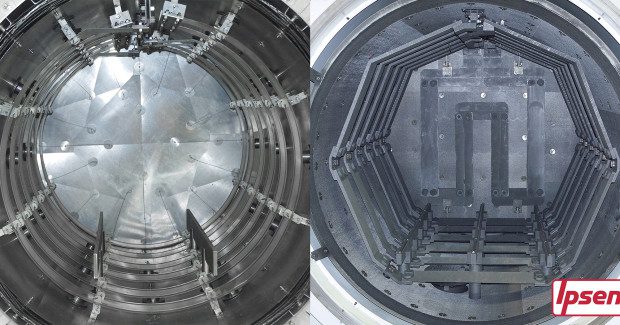Choosing the Best Hot Zone
This look inside the heat treating furnace examines the reasons behind the shift to graphite hot zones and identifies how shops can choose the best hot zone for their heat treating application.
Posted: May 5, 2015
Throughout the last 40 years, the heat treating industry has experienced a significant shift in the type of hot zone most commonly used in furnaces. In the 1970s, most of the hot zones installed were all-metal. Today, however, the vast majority are graphite. Two factors contributed to this shift in preference: improvement in the design and quality of graphite hot zones over the years, making them a more reliable option, and increased education about graphite’s uses and benefits among furnace users.
As manufacturers realized the advantages of using felt to prevent heat loss, the quality of graphite hot zones improved. Now it is common to see 2 in of graphite felt insulation backed with a Carbon/Carbon flex shield, whereas previously, hot zones consisted of a 1 in graphite felt and 1 in graphite board insulation. Angled heating elements with a custom-shaped configuration also enhance the design of graphite hot zones. This unique feature remove four rows of element hangers, thereby eliminating 24 possible areas that could incur dirt and minimizing shorting or looseness in the furnace. The custom-shaped heating elements also provide additional clearance to the workload.
Through research and data analysis, furnace users are more informed than ever when it comes to their equipment needs. As a result, the benefits of graphite hot zones have become more widely known, which contributed to the transition from all-metal options. Graphite is more energy efficient, costs considerably less to replace and can have a longer lifespan with proper maintenance.
While graphite hot zones have improved and gained more popularity in recent years, all-metal hot zones have maintained a strong demand in the industry. Compared to its alternative, all-metal hot zones are constructed using multi-layered, metallic shields consisting of molybdenum and stainless steel. Benefits of using this option include a better leak rate, improved pumpdown capabilities and a cleaner working environment with a lower probability of contaminated parts.
With the unique designs and advantages of each, you may find yourself wondering, “How do I choose the best hot zone for my needs?” We’ve identified three basic questions that can help you decide:
1) WHAT ARE YOUR PROCESS AND MATERIAL REQUIREMENTS?
All-Metal
If your process cannot tolerate incidental dust or dirt, an all-metal hot zone is the best choice for your needs; these sensitive processes include diffusion bonding and aluminum brazing. Specially engineered to handle materials such as super alloys (e.g., Titanium, Rene-80 nickel-based super alloy, Hastealloy and Tungsten), all-metal hot zones produce parts that come out bright and clean – a common requirement in the medical industry.
Also, consider how your materials might react with carbons in a graphite furnace. Graphite dust lowers melting temperatures and can have an adverse effect – even eutectic reactions – on certain materials. In cases such as these, an all-metal hot zone would be the best choice to ensure your parts reach the optimal results.
Graphite or All-Metal
Graphite is also capable of producing bright and clean parts, but incidental carbon dust can also occur. If your material does not react with carbon, then you have the flexibility to choose between hot zones. Most metals, such as carbon or alloyed steels, as well as processes including tempering, aging, carburizing, copper or nickel brazing, hardening and solution annealing would perform equally well in either hot zone.
2) WHAT ARE YOUR DESIRED TEMPERATURES AND RAMP RATES?
All-Metal
If your cycle requires high temperatures and ramp rates, you should choose an all-metal hot zone, which is capable of reaching temperatures above 2,400 deg F (1,371 deg C) and heating up at a maximum ramp rate of 75 deg F (41 deg C) per minute.
Graphite or All-Metal
If your temperatures are lower than 2,400 deg F (1,371 deg C) and you only require a maximum ramp rate of 45 deg F (25 deg C) per minute, you can select either hot zone.
3) WHAT IS YOUR EXPECTED RANGE OF TEMPERATURE UNIFORMITY?
All-Metal
A metallic hot zone with end elements is capable of achieving a temperature uniformity range of ±5 deg F (3 deg C). By AMS 2750E standards, a furnace within this range is defined as a Class 1 Furnace and provides the least temperature variation in the work zone.
Graphite or All-Metal
For parts and processes allowing a wider temperature uniformity range of ±10 deg F (6 deg C) or higher, a graphite hot zone without end elements can achieve the desired results. This variation of temperature uniformity, by AMS 2750E standards, is defined as a Class 2 Furnace. Since heat-treating furnaces should always be capable of meeting the narrowest temperature uniformity range that your parts or process demand, anything at or greater than this range could be achieved in either hot zone.
As you can see, each hot zone has distinct capabilities and advantages. If your answers to the above questions require you to select an all-metal hot zone, the decision is simple. But if you have the flexibility to choose between the two options, consider the benefits highlighted earlier in this post before choosing the best hot zone for your needs.
Ipsen Inc., 984 Ipsen Road, Cherry Valley, IL 61016, 815-332-4941, Fax: 815-332-4949, www.ipsenusa.com.











